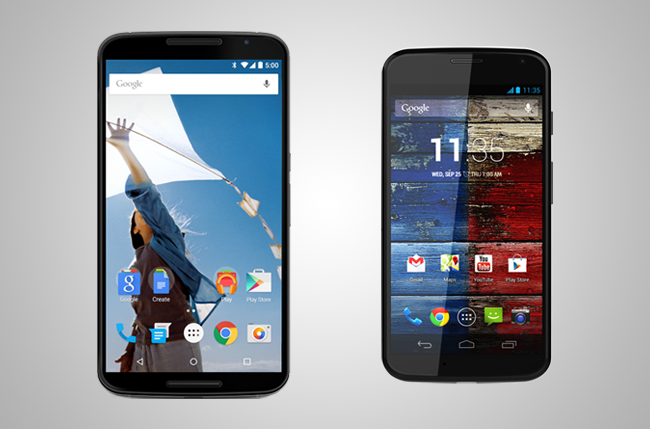
Despite its whale-ish proportions, the Nexus 6 closely resembles Motorola’s terrific Moto X (2014). How does the Nexus compare to Motorola’s flagship handset? Keep reading to find out.
Spec Comparison
Google Nexus 6 |
Motorola Moto X |
|
| Size | 6.27 x 3.27 x x 0.40 (in) | 5.54 x 2.85 x 0.39 (in) |
| Weight | 4.55 ounces | 5.08 ounces |
| Screen | 5.96 inch AMOLED | 5.2-inch OLED |
| Resolution | 2560 x 1440 pixels | 1920 x 1080 pixels |
| OS | Android 5 | Android 4.4 |
| Storage | 32 and 64 GB | 16 GB (32 GB through Moto Maker) |
| Processor | Quad core Krait 450 CPU 2.7GHz | Quad-core Snapdragon 801 |
| RAM | 3GB | 2GB |
| Connectivity | Bluetooth 4.1 | Wi-Fi, 4G LTE, HSPA+, NFC |
| Camera | 13MP Rear, 2MP Front | Front 2MP, Rear 13MP |
| Bluetooth | Yes, version 4.1 | Yes, version 4.0 + LE |
| Battery | 3220 mAh, 24 hours of talk time | 2300 mAh, 24 hours of talk time |
| Charger | microUSB 2.0 | microUSB |
| Marketplace | Google Play Store | Google Play Store |
| Avg. Price | $650 without contract | $500, $100 with a two-year contract |
| DT Review | Coming Soon | 4.5 out of 5 |
Power and Productivity
While the Moto X is powered by the same Qualcomm Snapdragon 801 processor that’s found in most high-end Android smartphones, the Nexus sports the next-gen Snapdragon 805 that is currently only offered in the Samsung Galaxy Note and Galaxy Note Edge. The updated processor has only a few nuanced differences over the Snapdragon 801, but the Nexus 6 will handle images and videos with higher resolutions thanks to use of the Adreno 420 GPU graphics card.
More important, however, is the ability for the Nexus 6 processor to extend battery life. But both the Nexus 6 and Moto X will run on Android 5.0 and, for the first time, implement a battery saving mode that will spread those last few percentage points over a longer amount of time.
Whats more, the Nexus 6 has an added 1GB of RAM. For all that is efficient about the Moto X, the Nexus 6 has a longer battery life, a snappier processor, and 33 percent more RAM. Neither handset offers an SD card slot for added storage.
Winner: Nexus 6
Design
Simply put, the Google Nexus is a larger version of the Moto X. The Nexus has the same curvy aluminum chassis and body shell, and even the Motorola logo inside a cute little dimple. However, there are a few minor differences. For starters, the Nexus 6’s massive, 5.9-inch display. It’s significant jump up from the Nexus 5’s 4.9-inch screen. Yes, it’s called Shamu for a reason– dwarfing the Moto X’s 5.2-inch screen and just about every other phablet on the market.
Aside from display size, the Nexus has made several, more subtle, changes to the Moto X, including a repositioned volume key and conveniently located sleep/wake key. But it’s easy to tell that Motorola is behind both handsets. The thin metal frame around the Moto X’s perimeter and a reduced bezel are also included in the Nexus 6 design. The Moto X’s signature matte-rear panel will be included on the Nexus as well.
However, the nearly 6-inch display may be too large for the conventional users. We loved the Moto X’s 5.2-inch screen and you’ll be happy to find that you’ve got nearly endless options to personalize your Moto X. For now, the Nexus 6 will initially be offered in black and white.
Winner: Moto X
Camera
Both handsets have nearly identical camera profiles, offering a 2-megapixel front and 13-megapixel rear camera. However, Motorola created underwhelming cameras in the past. Motorola worked hard to discredit its bad reputation with the Moto X, making a handset that does more than simply pack pixels into the camera sensor. Both the Nexus 6 and Moto X have rear cameras that utilize optical stabilizing technology. Essentially, this feature increases shutter speed and reduces blurry and otherwise out of focus photos. But thanks to the Snapdragon 805 processor, the Nexus will likely take a better picture, especially in low light.
Winner: Nexus 6
Price and availability
The Nexus 6 will cost $650 without a contract, but the price will drop significantly when paired with a two-year contract from a carrier. Still, we expect that the days of low-cost Nexus devices are over. Customers can get the Moto X with a 2-year contract for just $99 though, and it’s one of the best deals out there. Meanwhile, the Nexus 6 will be released sometime in November, so you’ll have to wait a while to get your hands on it.
Winner: Moto X
Conclusion
The Google Nexus 6 may have the specs to outshine the Moto X. Still, we haven’t actually gotten our hands on the flagship Google device just yet, so this spec showdown may raise more questions than it answers. Will a 5.9-inch handset be too large? How does Android 5.0 preform? We’ll soon find out and let you know. In the meantime, the Nexus 6 is certainly enticing.
Editors' Recommendations
- The 15 most important smartphones that changed the world forever
- Google Pixel 6a vs. Apple iPhone 13 Mini
- Samsung Galaxy S21 FE 5G vs. Google Pixel 6 camera shootout
- The Razer X Fossil Gen 6 smartwatch is only for the 1337
- Google Pixel 6 Pro vs. Samsung Galaxy S21 Ultra